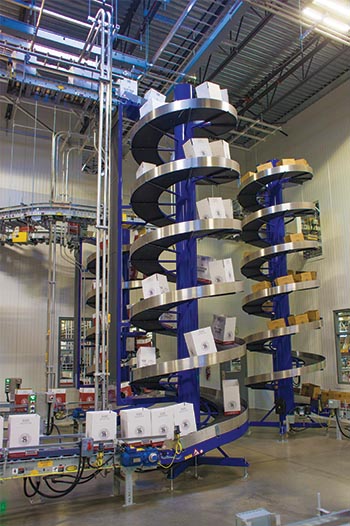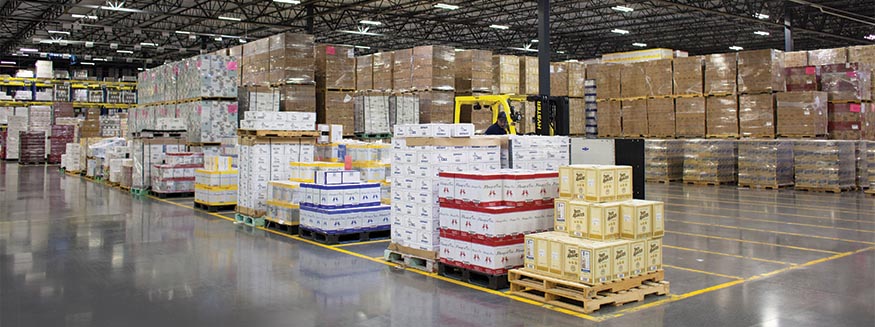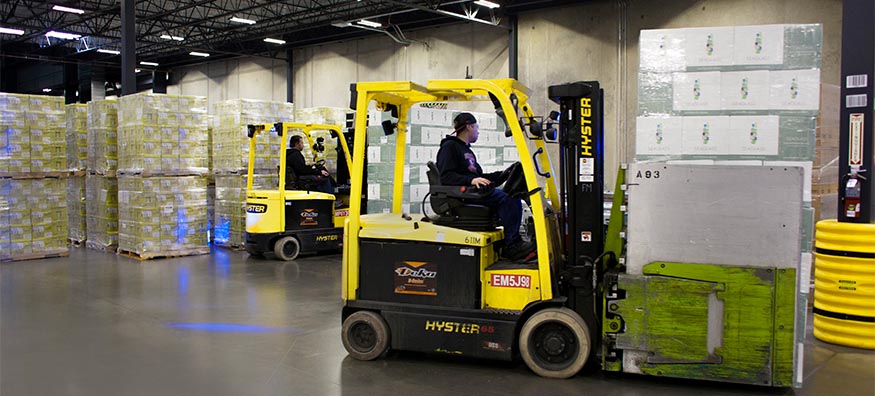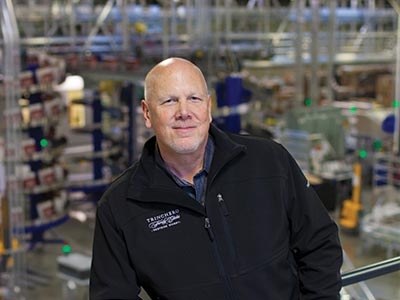Trinchero Family Estates: Pallet handling in the vineyard
The second-largest family-owned wine company in the world turns to automated pallet handling and storage for its winemaking and distribution operations.
Editor’s note: With all the talk of omni-channel, it’s no wonder the industry is focused on item level handling and picking technologies. But, many warehouses and distribution centers remain challenged with moving pallets quickly, efficiently and accurately. This month’s System Report on Trinchero Family Estates’ new winery is the second of two cover stories featuring the future of automated pallet handling systems.
Without question, there is a certain romance about something as ancient as wine. It’s easy to imagine that the nectar of the gods is still produced using methods that date back centuries.
While winemakers no longer stomp wines in a vat with their bare feet, like that old episode of “I Love Lucy,” many traditions endure in the process of winemaking, like aging wine in barrels. At the same time, wine is a global business and the best wineries are not only looking for new ways to improve their winemaking skills; increasingly, they are also improving the warehousing and distribution side of the house as well.
Wine, after all, is highly competitive with American producers competing here and abroad with wineries from Chile, Argentina, France, Italy, Spain, Portugal, Germany, New Zealand, Australia and South Africa and more. That is to say nothing of the constant introduction of brand extensions from existing wineries. While connoisseurs will pay hundreds, if not thousands, for a cult wine, the rest of us often choose a bottle based on the funky label that caught our attention in the grocery store aisle, where a $1 could be the difference between making a sale or not. Improvements in supply chain operations are the next competitive playing field.
Enter Trinchero Family Estates, the second-largest family-owned wine company in the world. Established in Napa Valley in 1948, Trinchero is best known for its Sutter Home line of wines, but in all produces more than 45 brands, including spirits. In 2015, Trinchero began building a one-of-a-kind winery and temperature-controlled warehouse on a 500-acre plot of land in Lodi, Calif., where it would focus on many of its successful premium brands. Incorporating Lean manufacturing principles, the facility is capable of bottling more than 26 million cases of production a year—on bottling lines that in some instances can fill 600 bottles per minute, generating 110 pallets per hour from three lines.

All of those pallets have to go somewhere, and in a hurry. To store and distribute all that production, Trinchero added a highly automated warehouse to the facility. The heart of the system is an automated pallet shuttle and storage system from PAS, now part of Swisslog. The automated storage and retrieval system (AS/RS) uses transfer carts, elevators and pallet carts—or pallet shuttles—in the storage aisles rather than the traditional AS/RS crane to induct a pallet, elevate it to the storage level chosen by the software control system, and put a pallet away or retrieve it from storage.
With four induction conveyors, 6,048 rows and 72,300 pallet positions for storage, the system can handle 250 pallets an hour into and out of the AS/RS, and store 4.2 million cases at any point in time. What’s more, as designed, the overall facility brings to winemaking Lean principles that are normally associated with automotive and other manufacturing industries.
See the in-depth systems setup at Trinchero here.
“From how we receive grapes, make the wine, finish it, transfer it to the bottling room, palletize it and stage it for shipping, there’s nothing quite like it in the world,” says Kent Mann, vice president of operations for the family-owned winery. “Full pallets go from the bottling line to the warehouse to the staging area in shipping without ever being touched by anyone.” He adds that the system can retrieve and stage a load for shipment in 24 minutes or less.
Even the relatively small amount of volume set aside for building mixed pallets is touched only twice—once when cases are put away into storage in a manual pallet build area and a second time when an associate picks the cases to a pallet. After that, the pallets are inducted into the automated warehouse and handled without manual intervention just like a full pallet from the bottling line.
Like the automation used by Preferred Freezer Services to handle pallets of frozen potatoes that we featured in Modern’s January 2018 issue, it’s an example of where automated pallet handling may be going in the future as companies like Trinchero and PFS focus more and more on the most efficient way to get product in and out of storage. “A big reason for this facility, including the automated warehouse, was to use technology to grow smartly,” says Mann. “Since going live, we’ve optimized it and continue to drive better performance.”
70 years of growth
Trinchero Family Estates may not be a household name, but many of its more than 45 brands are among the best-selling wines, including Sutter Home, Ménage à Trois, Neyers, Joel Gott, Napa Cellars and The Show, to name a few. Trinchero also produces a portfolio of spirits and distributes imported wines. In addition to its U.S. sales, the company ships to some 50 countries. In 2009, it was Wine Enthusiast’s Winery of the Year.
 The winery got its start in 1948 when Mario Trinchero moved from New York to St. Helena in Napa Valley and purchased the Sutter Home Winery. In 1958, Bob Trinchero joined his father Mario in the business as a winemaker, and in 1968, Trinchero released its first zinfandel, the varietal it would be best known for. A few years later, the winery introduced the first white zinfandel, the result of a problem with fermentation that left an intended batch of wine with a pink color and residual sugar. It was an instant hit, becoming the No. 1 selling premium wine in the United States in 1987, with nearly 3 million cases produced by 1989.
The winery got its start in 1948 when Mario Trinchero moved from New York to St. Helena in Napa Valley and purchased the Sutter Home Winery. In 1958, Bob Trinchero joined his father Mario in the business as a winemaker, and in 1968, Trinchero released its first zinfandel, the varietal it would be best known for. A few years later, the winery introduced the first white zinfandel, the result of a problem with fermentation that left an intended batch of wine with a pink color and residual sugar. It was an instant hit, becoming the No. 1 selling premium wine in the United States in 1987, with nearly 3 million cases produced by 1989.
The ensuing decades were characterized by steady growth. In 2004, Trinchero purchased the Folie à Deux winery and launched the Ménage à Trois red blend. With the second generation running the company—and the third generation coming along—it has grown its case volume and portfolio, along with the rest of the industry. That growth led to the new winery and automated warehouse.
“I’ve been in the wine industry for almost 20 years, and the challenge for everyone has been to develop infrastructure that can keep up with brand expansions, the introduction of new products and more volume as we target new customers,” says Mann.
The other challenge: Doing all of that in a way that is as efficient as possible. And, from a supply chain point of view, there was room for improvement at Trinchero. Up until 2015, when the new winery went live, most of the grapes that go into Trinchero’s wines were grown within 20 miles of Lodi, in California’s Central Valley, and much of the wine was produced there as well. But, when it came time for bottling, the wine was shipped some 60 miles to Napa Valley, where it was bottled and shipped to customers. Trinchero operated two conventional warehouse facilities in Napa.
Plans to create a leaner strategic supply chain—even if they didn’t call it that—got underway as far back as 1997, when Trinchero began the purchase of three separate plots of land that now total close to 500 acres in Lodi. “After the first purchase in 1997, and over the following 15 years, the company thought strategically about how to leverage this location,” says Mann, who joined Trinchero in 2014 after many of the plans were in place.
Part of that strategy was to focus on luxury wines in Napa Valley while moving the winemaking of premium and super premium wines that are produced in larger volumes to Lodi. And in Lodi, Trinchero wanted to produce, bottle and store the wines in one high-speed and highly automated facility that shortened the distance from the vineyard to the bottle, reducing Trinchero’s overall footprint. The result is three high-speed bottling lines, with room for a fourth. Currently, the facility can generate 110 pallets per hour, requiring a new pallet of empty glass bottles to be inducted as fast as every three and a half minutes.
Automating the warehouse
In Napa Valley, the Trinchero team was staffed with classic warehouse operators. “We utilized clipboards, relied on memory for where things were staged and counted inventory manually every month,” Mann says.
Doing things the same old way was not going to work in this new environment, where speed was king. Instead, the company realized it needed warehousing and distribution capabilities as state-of-the art as the bottling line.
There were at least five goals for the new automation:
- Small footprint: “Land is precious in California, and you also have to think about environmental impact,” says Mann. For that reason, Trinchero wanted to manage its projected volumes in as small a footprint as was possible, while allowing room for growth.
- Fast and weighty: The system not only had to keep up with the bottling line today, it had to be able to keep up with an additional fourth bottling line planned for the future. But more than that, the automation had to be able to move at speed while handling the weight of a full pallet of wine.
- Utilization: “We have more than one finished goods inventory peak during the year, so it was important that we had a solution that allowed us to optimize the space we have,” says Mann. “We don’t want to add additional warehouse space as we grow until we absolutely have to.”
- Speed to market: Most product is shipped with intermodal trailers and over-the-road shipments, with a smaller percentage of box cars and export containers. Trinchero wanted a system that would allow it to stage loads for delivery as fast as possible and also as accurately as possible.
- Flexible: While nearly 90% of shipments are full pallets, there is still demand for mixed pallets that include smaller volumes of high end or new brands. Overall, the warehouse had to include an area where mixed pallets could be built manually and then inducted into the automation.
- Temperature control: With a small footprint, the high-density storage enables more efficient cooling of the warehouse space. “We hold the warehouse temperature at 58ºF, which greatly helps wine quality,” Mann says.
While Trinchero engineers visited sites around the country to look at different technologies, the automated storage and pallet shuttle system ultimately chosen was found quite literally in Trinchero’s backyard. “PAS, the automation supplier, was located about 20 miles down the road from us,” says Mann. “Since this type of warehouse was designed to handle full pallets of finished goods, including beverages, it was the best fit for our business.”

Mixed case pallets are built in the conventional pick area and then inducted into the AS/RS.
At 180,000 square feet of automated storage and 72,300 pallet positions, it was the biggest project the provider had undertaken. But, having the supplier nearby mitigated risk. “They were close enough to respond very quickly if we needed them,” says Mann. “Their engineers and technicians live in the same area as we do, and they were embedded here during the start-up. They were able to help us with a lot of refinements from a hardware and software perspective.” As noted earlier, PAS is now part of Swisslog.
Going live
The pallet-handling process at Trinchero is relatively simple to follow. After bottling, cases of wine are automatically palletized, stretch wrapped and labeled with a license plate bar code label. With the creation of the bar code label, the finished goods on the pallet are introduced into SAP’s inventory management module followed by an electronic handshake that tells the automated storage system what’s coming down the line. The AS/RS control software, meanwhile, will determine the optimal location for that pallet, based on where other pallets of the same lot and SKU are stored. Everything is managed on a first-in, first-out (FIFO) basis.
The pallet then passes through a portal where it is scanned to verify its dimensions and load integrity before moving onto a spur. From there, it travels along an inbound induction loop on a cart that transfers it to one of four elevators servicing the storage modules for putaway by an aisle cart into a storage location.
When it’s time for staging, an aisle cart retrieves a required pallet and delivers it to an outbound elevator on the opposite side of the warehouse. On the ground level, it is delivered to a staging area.
While the process has only a few simple steps, going live was anything but simple. Trinchero, after all, was making the leap from manual to automated processes. “You cannot over prepare for a change like this,” Mann advises. He notes that the Trinchero team spent several months preparing for the change-over. They built scenarios for practice and ran simulations.
A significant effort went into ensuring that the communication link between SAP and the PAS software was in place because accurate inventory is a government requirement in the wine and spirits industry. “The handshake between the two systems had to be accurate,” Mann says. “This system provides us with 100% accurate inventory for all wine stored in the automated warehouse.”
It was also important to senior leadership that at least one Trinchero employee was an expert in the controls software. “We didn’t want to rely on our vendors for service,” Mann says. “We wanted someone who took ownership of the system and could drive improvements.” In addition, a group of super users were trained in SAP’s warehouse management system (WMS) and the overall warehouse processes that would be used in the new space.

Loads are loaded onto rail cars with clamp trucks.
Finally, maintaining a highly automated system was a new challenge. To that end, Trinchero sent a team down the road to another site operated by California Natural Products, which originally developed the technology. There, they learned how to keep the system running, and developed a custom preventative maintenance (PM) schedule to support the new system.
“We now have a mechanic and a controls tech assigned to each shift,” says Mann. “The mechanic is constantly doing PMs on the system and the controls tech is there to support any troubleshooting requirements.”
In Mann’s view, careful preparations paid off. “We shut down shipping for a week, but once we brought the system up, we didn’t miss a beat,” he says. “Our goal was a successful startup with minimal impact to the customer, and we delivered on that.”
Moreover, having a talented team of leaders, engineers and maintenance professionals onsite has led to performance improvements. While it originally took about 40 minutes to bring a load out of storage and stage it for shipping, that process now takes 24 minutes or less. They are also tweaking the storage system to improve “compaction,” or how efficiently each of the rows in the automated warehouse is used. “Right now, we’re getting up to 90% compaction, and we’re doing that while still supporting FIFO,” says Mann.
Today, Trinchero has an automated warehouse that complements a best-in-class wine production and bottling operation and positions the company for the future. More importantly, the company is taking the lessons learned in Lodi and applying them to the rest of its operations. “As a business, we’ve done everything we can to optimize this system,” Mann says.













